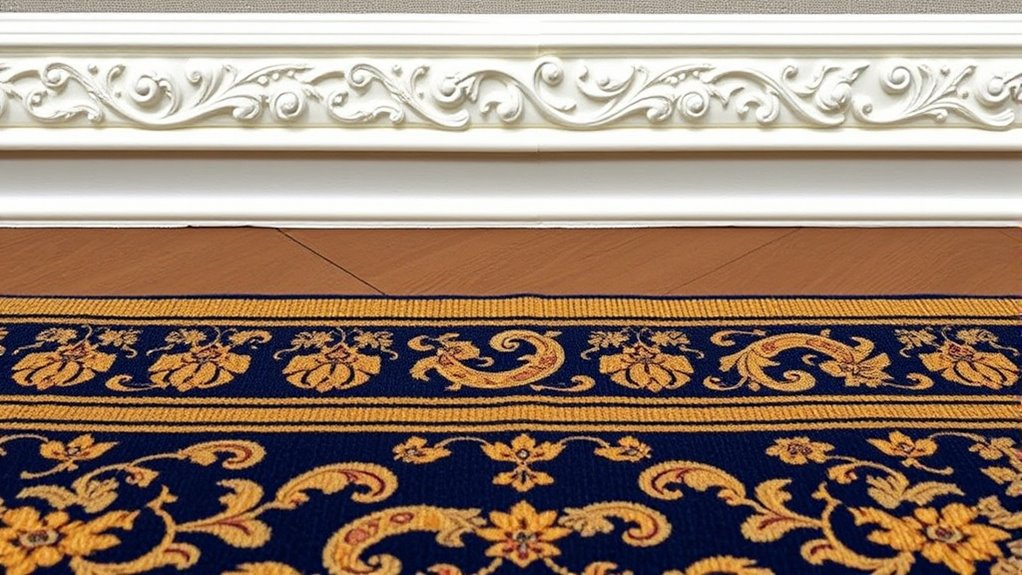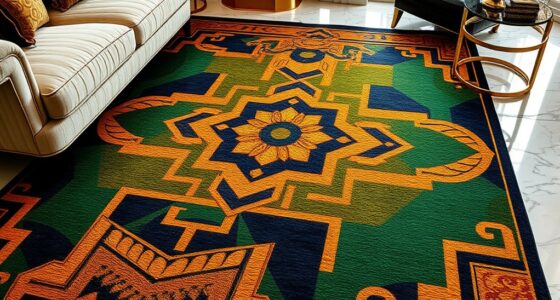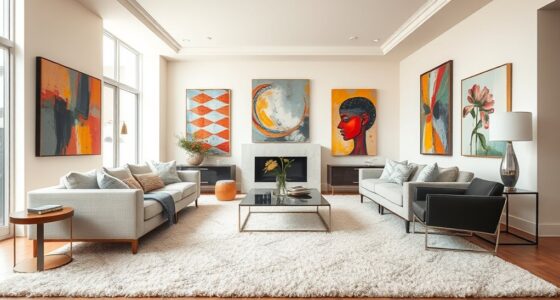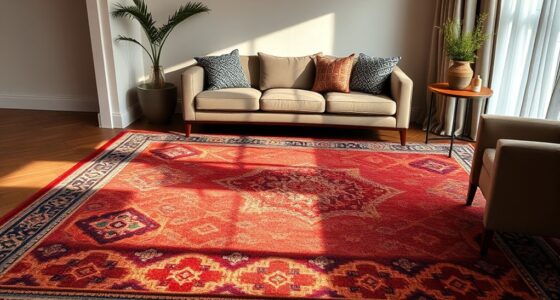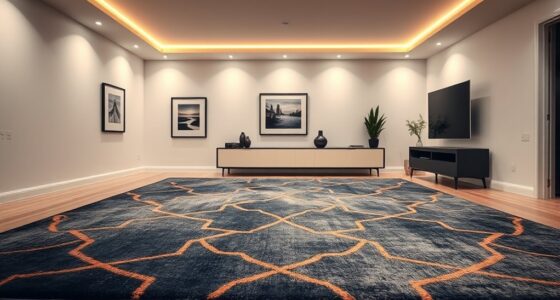To match rug borders to architectural mouldings, consider the style and material of your mouldings first. Ornate Victorian mouldings work best with intricate, detailed borders, while sleek modern ones suit minimalist patterns. Use colors that complement or contrast thoughtfully, and select textures and pattern scales that balance the overall space. Subtle coordination creates a cohesive look. Keep in mind how these elements work together, and you’ll find plenty of tips to perfect your interior harmony.
Key Takeaways
- Match ornate mouldings with intricate or detailed rug borders for visual harmony.
- Use minimalistic borders to complement simple, sleek mouldings and avoid clutter.
- Coordinate border colors with moulding hues for cohesive color harmony or deliberate contrast.
- Select rug patterns and textures that reflect the architectural style, such as ornate for Victorian or sleek for modern interiors.
- Consider the scale of the rug border relative to the moulding to enhance room proportions and overall aesthetic balance.
Understanding the Types of Architectural Mouldings
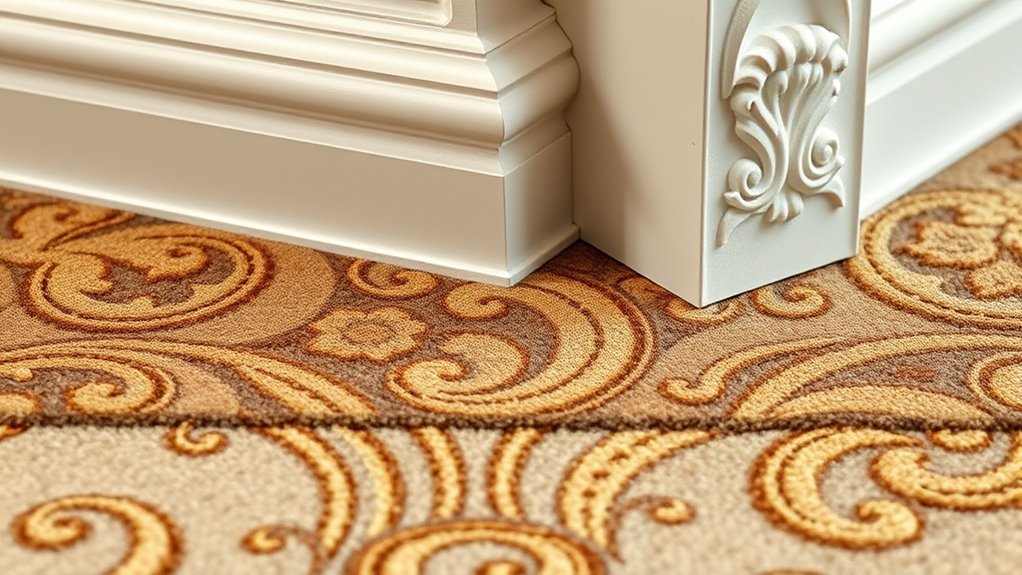
Understanding the types of architectural mouldings is essential for matching rug borders effectively, as each moulding style adds a distinct character to a space. Ornamental mouldings come in various forms, from crown and base mouldings to picture rails and cornices. Recognizing these styles helps you select complementary rug borders that enhance the overall design. Molding materials also play a key role; wood, plaster, and polyurethane each provide different textures and finishes, influencing the look and feel of the space. For example, intricate plaster mouldings often pair well with richly textured rug borders, while simpler wood mouldings suit more understated designs. Additionally, understanding moulding materials can help you choose textures and finishes that harmonize with your rug borders and overall interior aesthetic. By understanding both ornamental mouldings and their materials, you can create harmonious *passages* between architectural features and your rug borders.
Choosing Complementary Rug Border Styles
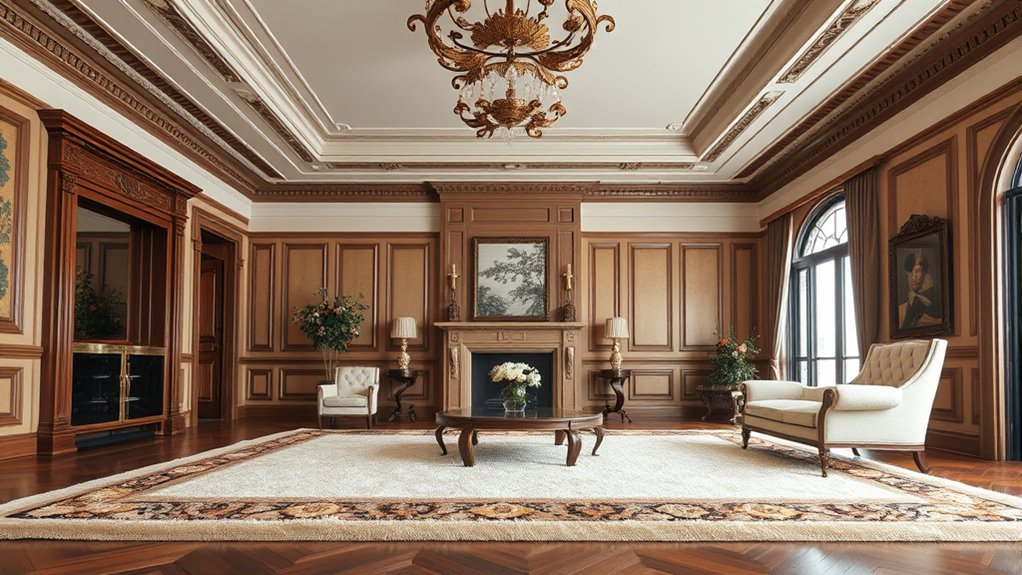
Once you’ve identified the style and material of your architectural mouldings, selecting rug border styles that complement them becomes more straightforward. Focus on pattern coordination to ensure harmony. If your mouldings are ornate, choose rug borders with intricate designs or detailed patterns. For simple mouldings, opt for minimalistic borders that won’t compete for attention. Consider the overall aesthetic—traditional mouldings pair well with classic rug borders, while modern interiors benefit from sleek, streamlined options. Use the table below to match different moulding styles with suitable rug border styles:
| Moulding Style | Recommended Rug Border Style |
|---|---|
| Ornate | Intricate patterns |
| Minimalist | Simple, clean lines |
| Classic | Traditional, detailed |
| Modern | Sleek, understated |
| Decorative | Bold, patterned borders |
Additionally, paying attention to exfoliation methods can enhance the overall look of your space by ensuring your rugs and mouldings remain in pristine condition.
Selecting Colors to Harmonize With Mouldings
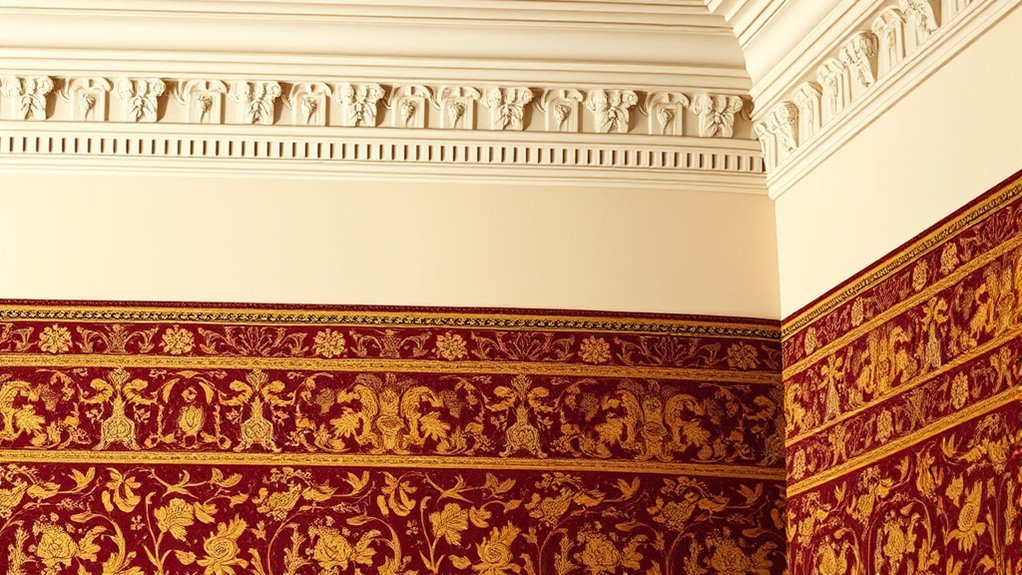
Choosing the right colors can make your mouldings stand out or blend seamlessly with your decor. Use color compatibility tips to pick shades that complement your existing palette. This approach will enhance your moulding accents and create a cohesive, polished look. Incorporating diverse design options can further elevate the overall aesthetic and ensure your space feels harmonious.
Color Compatibility Tips
To create a cohesive look, start by selecting colors that naturally complement the tones of your mouldings. Focus on achieving hue harmony by choosing shades that blend well with the moulding’s color family, whether warm or cool. When aiming for color contrast, pick hues that stand out against the moulding without clashing, such as a deep navy against white trim or soft beige with darker accents. Consider the overall ambiance you want to create—softer colors for a calm, unified appearance, or vibrant shades for a lively contrast. Keep in mind that subtle variations in hue can enhance harmony, while contrasting tones add visual interest. Additionally, understanding the signs of spoilage in lemon juice can help you maintain fresh ingredients for your decorating projects. Ultimately, balancing color contrast and hue harmony helps your rug border and mouldings work together seamlessly.
Enhancing Moulding Accents
Harmonizing rug borders with moulding accents begins with selecting colors that highlight and complement the mouldings’ details. Focus on shades that enhance ornamental accents and decorative motifs without overpowering them. Neutral tones like soft beiges or warm grays serve as versatile backgrounds, allowing intricate moulding details to stand out. For more decorative motifs, choose colors that echo or contrast the mouldings’ hues, creating visual interest. Consider accentuating ornamental accents with subtle pops of color, such as muted golds or deep blues, to add depth. The goal is to create a balanced palette that emphasizes the mouldings’ craftsmanship while making your space feel cohesive. Thoughtful color choices will elevate your decor, emphasizing the elegance of your architectural features. Incorporating color harmony principles can further ensure your rug borders complement your mouldings beautifully.
Tips for Coordinating Patterns and Textures
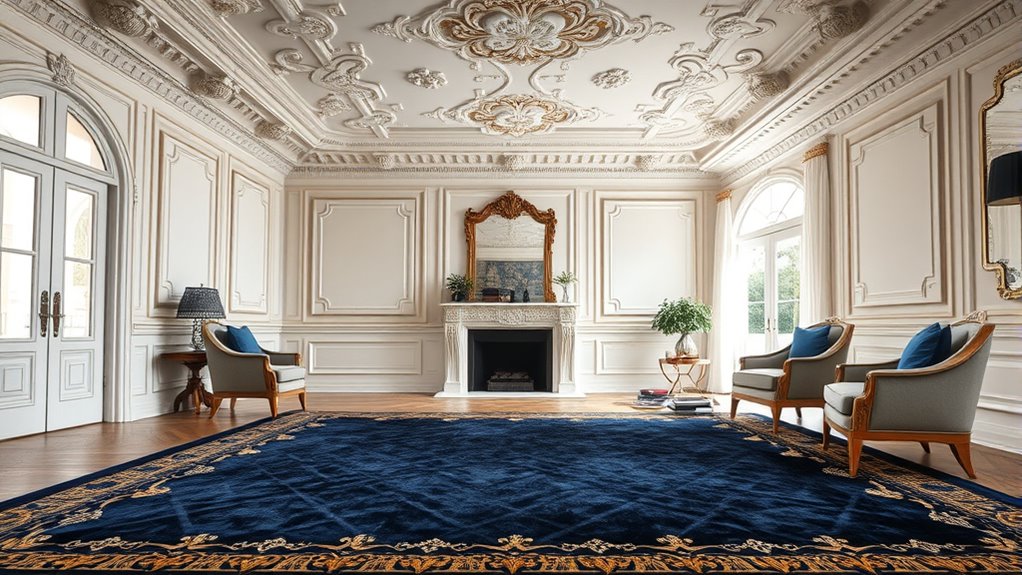
When coordinating patterns and textures, start by matching color palettes to create a cohesive look. Be mindful of balancing pattern scales so your rug border enhances rather than overwhelms your space. Additionally, incorporate architectural details to guarantee your textures complement the overall design. To achieve a truly authentic farmhouse aesthetic, consider natural materials that bring warmth and rustic charm into your bedroom.
Match Color Palettes
Choosing the right color palette is essential for creating a cohesive look between your rug borders and architectural mouldings. Focus on color contrast to highlight features or blend seamlessly for harmony. Incorporate texture variation through different finishes or materials to add depth without clashing. To guide your selection, consider this table:
| Color Approach | Effect |
|---|---|
| Complementary Colors | Creates vibrant contrast and visual interest |
| Monochromatic Tones | Maintains subtle unity and sophistication |
| Analogous Colors | Offers harmony with gentle variation |
Matching palettes involves balancing bold contrasts with subtle shades. This ensures your rug borders and mouldings work together, emphasizing textures and avoiding overwhelming the space. For example, using Pimple Patch techniques can be likened to selecting the right patch for targeted treatment—precise and effective in enhancing overall appearance.
Balance Pattern Scale
Balancing pattern scale is essential for creating a cohesive look between your rug borders and architectural mouldings. Achieving scale harmony involves choosing patterns that complement each other in proportion. If the patterns are too large or bold, they can overpower delicate mouldings; if too small, they may seem insignificant. Focus on pattern proportion to guarantee visual balance. For example, pairing a medium-sized border with intricate detailing works well with larger architectural features, while smaller mouldings benefit from more subtle, refined patterns. Keep the overall visual flow in mind, avoiding overwhelming contrasts or mismatched scales. By paying attention to pattern proportion and maintaining scale harmony, you create a seamless integration that enhances your space’s architectural beauty. Additionally, considering interior design principles can help you select the right pattern scale to complement your decor style.
Incorporate Architectural Details
Incorporating architectural details into your rug borders enhances the harmony between your floor and the surrounding moldings. Focus on decorative motifs that mirror the shapes and patterns found in your moldings, such as floral designs, geometric shapes, or classical elements. Drawing inspiration from historical influences can help you select motifs that complement the era of your architecture, creating a cohesive look. For example, if your space features Victorian moldings, consider intricate, ornate borders; for modern styles, opt for sleek, minimalist patterns. By matching these details, you reinforce a unified aesthetic, making your space feel thoughtfully curated. Understanding the design principles behind architectural styles can further guide you in selecting complementary patterns. This approach guarantees your rug acts as an extension of your architectural style, blending textures and patterns seamlessly.
Practical Guidelines for Mixing and Matching
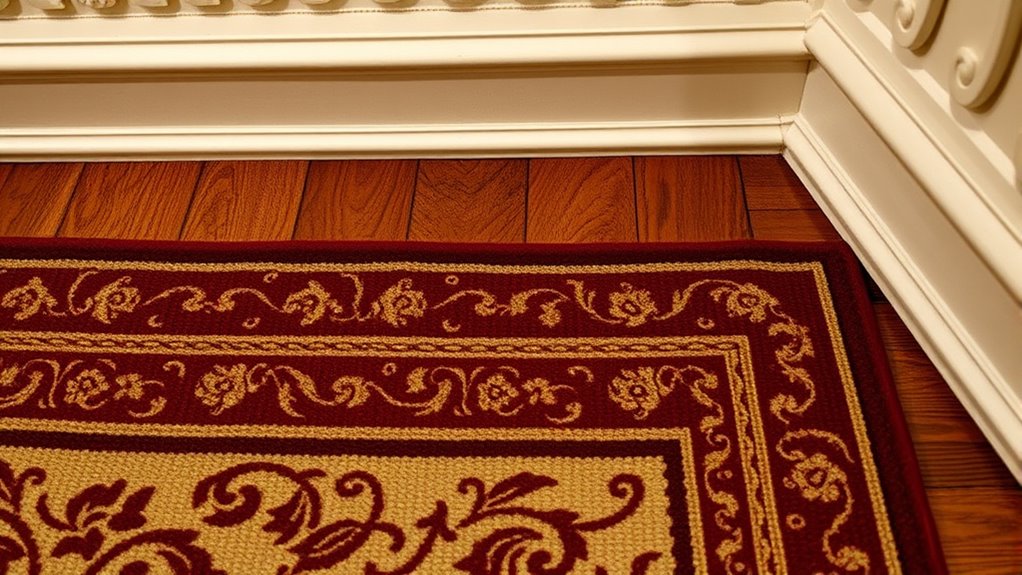
When mixing and matching rug borders with architectural mouldings, practical guidelines can help you achieve a cohesive and harmonious look. First, consider your rug material options—choose textures that complement your mouldings, like plush for ornate trims or natural fibers for simpler profiles. Second, pay attention to rug size considerations: a rug that’s too small can disconnect the space, while one that’s too large might overwhelm the mouldings. Aim for a size that enhances the room’s proportions and highlights the mouldings’ details. Third, ensure your border colors and patterns work together—use contrasting shades for visual interest or matching tones for unity. Additionally, understanding the self watering planters concept can inspire you to select materials and designs that harmonize with your overall decor. By following these tips, you’ll create a balanced, inviting space that feels thoughtfully curated.
Enhancing Interior Cohesion With Subtle Details
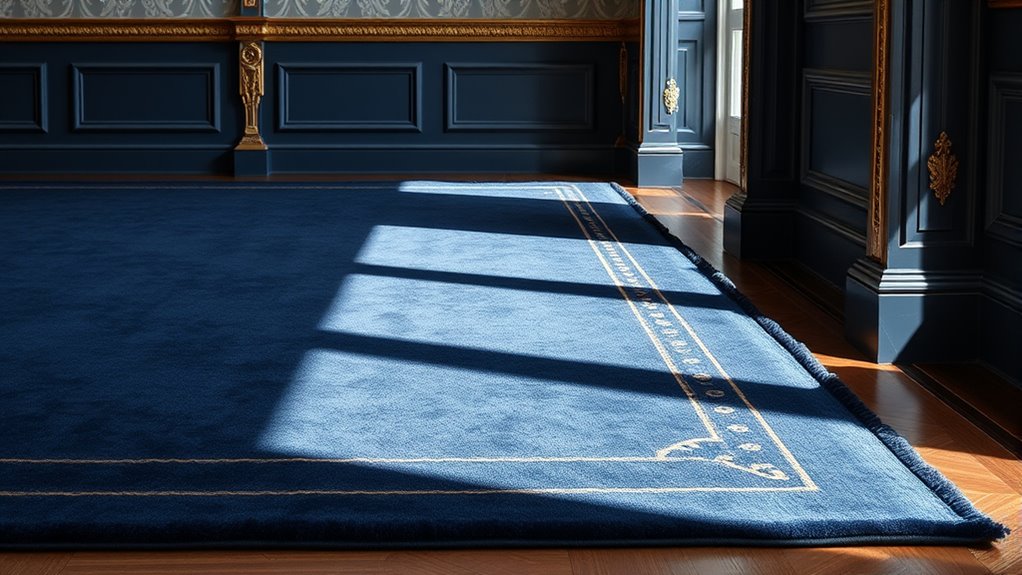
Subtle details can substantially enhance the overall harmony of your interior design without overwhelming the space. Incorporate matching doorway trims and ceiling cornices to create a seamless flow between different areas. When these elements echo the style or color of your rug borders, they reinforce visual cohesion. For example, a delicate molding around doorways that mirrors the pattern or tone of your rug’s border ties the room together subtly. Similarly, ceiling cornices with simple, elegant profiles can act as a unifying feature, drawing the eye upward while complementing other mouldings. These small but intentional details make your interior feel thoughtfully curated, providing understated elegance that elevates the overall aesthetic without cluttering the space.
Frequently Asked Questions
How Do I Measure My Rug to Match Moulding Proportions Accurately?
To measure your rug accurately, start with precise measuring techniques using a tape measure. Focus on the proportions by comparing the rug size to nearby architectural mouldings, following basic proportion guidelines. For example, make certain the rug’s border complements mouldings without overwhelming or underwhelming the space. Keep your measurements consistent, note down all dimensions, and adjust as needed to achieve a balanced, harmonious look that aligns with your moulding proportions.
Can Matching Rug Borders to Mouldings Work in Open-Concept Spaces?
Imagine a wild jungle gym of open spaces, where matching rug borders to mouldings becomes a daring adventure. In these vast areas, you can still achieve visual harmony and design continuity by carefully selecting borders that complement, not clash, with your architectural details. It’s like orchestrating a symphony—balance is key, and thoughtful coordination guarantees your space feels cohesive, even in the grandest, most open of layouts.
What Are Common Mistakes When Coordinating Rug Borders With Mouldings?
When coordinating rug borders with mouldings, you might encounter common mistakes like border clash or color mismatch. To avoid this, make certain your rug border complements the moulding’s color and style, rather than competing with it. Don’t choose a border that’s too bold or contrasting, as it can create visual dissonance. Instead, aim for harmony, blending the border seamlessly with the moulding to achieve a cohesive and polished look.
How Often Should I Update Rug Borders to Stay Aligned With Evolving Moulding Styles?
You should update your rug borders with decorating trends and seasonal updates every couple of years to stay current. As moulding styles evolve, revitalizing your borders helps maintain a cohesive look in your space. Pay attention to seasonal changes and new design influences, and don’t be afraid to experiment. Regular updates ensure your decor remains stylish and aligned with modern aesthetics, keeping your home lively and inviting.
Are There Specific Rug Border Materials Best Suited for Different Moulding Types?
Imagine your room as a canvas, where fabric choices and color coordination create harmony. For different moulding types, choose rug border materials that complement their style—silk or velvet for ornate mouldings, natural fibers like jute for rustic designs. These choices enhance aesthetic unity, ensuring your space feels cohesive. Selecting appropriate materials helps your rug border seamlessly echo your architectural details, tying the entire room together with elegance and intentionality.
Conclusion
By matching rug borders to your architectural mouldings, you create a space that’s as harmonious as a well-composed symphony. Think of it like tuning a guitar—you want every element to complement each other perfectly. With a little attention to detail, you can effortlessly blend textures, patterns, and colors. The result? An interior that feels balanced and inviting, just like a cozy room where every piece plays its part beautifully.
